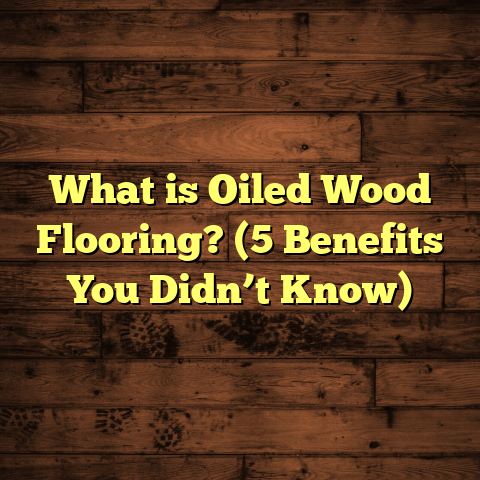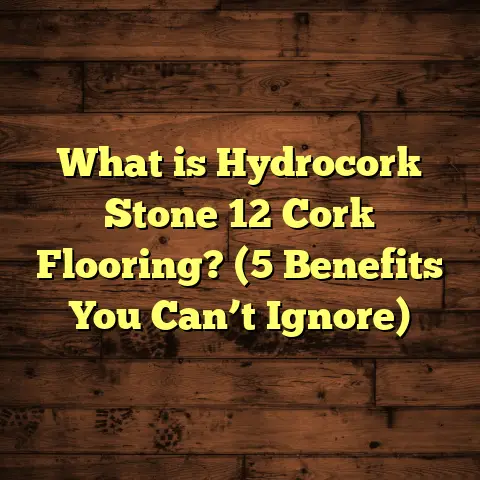What is Better Flooring: Maple or Hickory? (5 Key Differences)
What is Better Flooring: Maple or Hickory? (5 Key Differences)
I’ll never forget the day I first realized how much wood flooring choices could impact not only the look of a home but also its functionality. I was knee-deep in a renovation project for a family who was torn between two popular hardwoods: maple and hickory. They loved the clean look of maple but were drawn to the rugged charm of hickory. At that moment, it hit me—picking the right wood is not just about aesthetics; it’s about lifestyle, durability, maintenance, cost, and even environmental impact. Over the years, I’ve installed both types in various homes, learning what works best where. If you’re stuck on which one to pick, stick around—I’m going to break down five key differences that will help you decide.
What is Maple and Hickory Flooring?
Before we get into the nitty-gritty, it’s helpful to understand what exactly maple and hickory flooring are.
Maple Flooring
Maple flooring comes from the maple tree, mainly the hard maple species (Acer saccharum), which is native to North America. This wood is known for its fine grain and a light, creamy color palette that tends to brighten up any room. Maple trees grow relatively quickly compared to many hardwoods, making maple floors an attractive option for those interested in a sustainable choice.
One thing I’ve noticed over time is how versatile maple is when it comes to design styles. Its subtle grain and light color make it a favorite for modern, minimalist homes but it also works well in traditional spaces when stained darker.
Hickory Flooring
Hickory flooring comes from the hickory tree, particularly shagbark hickory (Carya ovata) and shellbark hickory (Carya laciniosa). Hickory is also native to North America and is prized for its incredible hardness and striking grain patterns.
Unlike maple’s uniform look, hickory floors often have bold color variations within the same plank—ranging from pale tans to deep browns and reddish streaks. This gives hickory a rustic, lively appearance that adds character to any space.
I’ve installed hickory in cabins, country homes, and even some downtown apartments where clients wanted their floors to stand out as a statement piece.
1. Durability and Hardness: Which One Can Take More of a Beating?
Hardness is one of the first questions I get asked when clients are choosing between maple and hickory. They want floors that can handle daily life without showing every scratch or dent.
The Janka Hardness Scale Explained
The best way to compare wood hardness is by looking at the Janka hardness scale. This test measures how much force it takes to embed a small steel ball halfway into the wood.
- Maple scores about 1450 on the Janka scale.
- Hickory scores significantly higher at around 1820.
This means hickory is considerably harder and more resistant to dents and scratches than maple.
What Does That Mean for You?
If you have kids, pets, or entertain often, you’ll appreciate how hickory stands up to heavy use. I remember one family with three energetic dogs who installed hickory floors in their living room. After a year of running, sliding toys, and even the occasional dropped dish, their floors showed barely a mark.
Maple floors can dent more easily under heavy impact but still hold up well in normal household environments. Their smooth surface means dents are less noticeable visually compared to woods with prominent grain.
Real-Life Experience
In one project at a local school gymnasium office area, we installed maple floors because we wanted a bright, welcoming look. The staff loved how clean and modern it looked. However, after a couple of years, small dents appeared near heavy furniture legs.
Contrast that with a mountain cabin I worked on where hickory floors survived decades of heavy boots and furniture scrapes with minimal damage.
Refinishing Considerations
While hickory is harder and more durable, it can be more challenging to sand and refinish because of its density. Maple’s softer nature means refinishing goes faster and smoother—a useful factor if you plan to resurface your floors every few years.
2. Aesthetic Appeal and Grain Patterns: Which Look Fits Your Style?
Wood flooring isn’t just functional; it’s a big part of your home’s style statement. The difference between maple and hickory here is like choosing between classic elegance and bold personality.
Maple’s Subtle Elegance
Maple features a fine, uniform grain that creates a smooth surface with minimal texture. Its colors range from creamy white through light reddish-brown hues.
This makes maple incredibly versatile for different decor styles:
- Modern/Minimalist: The light color brightens rooms and pairs beautifully with sleek furniture.
- Traditional: When stained darker, maple can mimic more expensive woods like cherry or walnut.
- Scandinavian: Its clean look fits perfectly with simple, natural aesthetics.
I once helped a client create a Scandinavian-inspired living room with wide plank maple floors finished in matte clear coat. The floor’s subtle grain allowed her furniture and textiles to truly pop without visual competition.
Hickory’s Bold Character
Hickory brings dramatic grain variations that feature knots, streaks, and a mix of light and dark colors within each board. This creates a rustic look full of life and warmth.
It fits best in:
- Rustic/Cabin: Perfect for mountain homes or rural settings.
- Industrial: The rugged texture adds an element of rawness.
- Eclectic: The variability keeps things interesting and unique.
I’ve seen some designers use hickory as a focal point—installing it in entryways or kitchens where it adds an immediate wow factor.
Color Variations & Stains
Both woods take stains well but behave differently:
- Maple’s uniform grain means stains appear even but can sometimes look blotchy if not pre-treated.
- Hickory’s natural color variation means stains highlight or mute certain areas unpredictably—something I always warn clients about.
3. Cost Differences: What Will Your Budget Say?
Price matters more than just materials; installation costs can vary too depending on wood hardness and finish.
Materials Cost
Based on my experience and data from suppliers:
- Maple: $3–$5 per square foot for materials.
- Hickory: $4–$7 per square foot for materials.
This range depends on grade (select vs. rustic), finish type (unfinished vs. prefinished), and local market variations.
Installation Costs
Harder woods like hickory usually require extra effort during sanding and finishing, which can add labor costs by 10–15%.
When I quote jobs today, I use FloorTally—a tool that helps me factor in local labor rates, material costs, waste percentages, and finishes all in one place. It saves me from juggling multiple spreadsheets or hunting prices online.
For example, on a recent project where I was pricing both options side by side, FloorTally showed the total cost difference between maple and hickory flooring installation was about 20%. That helped my client decide based on actual numbers rather than guesses.
Long-Term Investment
While hickory might cost more upfront, its durability often offsets replacement or repair costs over time. Maple flooring may need refinishing more often due to dents but tends to be cheaper initially.
4. Maintenance and Longevity: How Much Work Will Your Floors Need?
Maintaining hardwood floors isn’t just sweeping—how they age depends heavily on the species you choose.
Cleaning & Routine Care
Both maple and hickory respond well to regular cleaning like sweeping or vacuuming with soft brushes and damp mopping with hardwood floor cleaner.
But:
- Maple’s tight grain means dirt doesn’t hide easily on its surface.
- Hickory’s varied grain and color patterns can mask dirt better but might trap particles in crevices more easily.
Wear Over Time
Maple floors tend to show scratches more clearly because of their lighter color but are easy to refinish thanks to their smooth grain.
Hickory floors develop a patina—a subtle darkening with wear—that many people find adds character. However, sanding hickory can be trickier due to its hardness, so refinishing is less frequent but requires more effort when done.
My Experience With Wear Patterns
One homeowner I worked with had maple floors that looked fantastic for years but finally needed refinishing after about 8 years due to visible scratches from kids’ toys.
Another client with hickory flooring reported minimal visible wear after 10 years despite heavy traffic but waited longer before refinishing because sanding was tougher work for contractors.
5. Environmental Impact and Sustainability: Which Flooring Choice Is Greener?
If sustainability matters to you like it does to me, knowing how your flooring affects the environment can tip the scales.
Growth Rates & Harvesting
Maple trees grow faster than most hardwoods—about 40-50 years to maturity—making maple a somewhat renewable option when responsibly harvested.
Hickory grows slower (60-80 years) but its durability means fewer replacements over time—less waste overall.
Both species are native to North America, so sourcing locally reduces transportation emissions compared to exotic imports.
Certifications & Responsible Forestry
Look for certifications like FSC (Forest Stewardship Council) or SFI (Sustainable Forestry Initiative) when buying either wood. These ensure forests are managed sustainably without clear-cutting or habitat destruction.
In my projects focused on green building standards like LEED-certified homes, both woods qualify if sourced correctly.
Lifecycle Analysis
Studies show durable floors like hickory have lower environmental impact over decades because replacements are less frequent despite slower growth rates.
Maple’s faster growth means quicker replenishment but possibly more frequent refinishing cycles which consume energy and materials.
Bonus Insight: How I Use FloorTally To Manage Costs Efficiently
Budgeting flooring projects can be tricky with fluctuating prices for materials and labor across regions. For years, I’ve relied on FloorTally as my go-to tool for estimating costs accurately without chasing numerous quotes.
It lets me input:
- Square footage
- Material types (maple or hickory)
- Local labor rates
- Waste percentages
- Finish options
This combination gives me an estimate that matches real-world prices closely—saving time and helping set realistic expectations for clients.
For example: On one recent project comparing maple vs. hickory flooring for a 1000 sq ft space, FloorTally showed total costs including installation as:
- Maple: $9,500
- Hickory: $11,800
That clear number made decision-making straightforward for my client who appreciated transparency over guesswork.
Personal Stories from My Floor Installations
I’ve been lucky enough to install both maple and hickory floors in hundreds of homes—from cozy cabins to urban condos—and every project taught me something new about these woods.
One memorable job was a rustic lodge where we used wide plank hickory floors that instantly warmed up an otherwise cold stone interior. The homeowners loved how each board told its own story through knots and streaks—plus the hardiness kept their floors looking fresh despite heavy foot traffic from guests over winters.
On another occasion, I installed classic maple floors in a sleek city apartment where natural light poured through large windows. The soft glow on the smooth maple surface complemented modern furnishings perfectly. The client especially loved how easy it was to keep clean despite having two cats.
Detailed Data & Case Studies
To back up my experience with data:
- According to the Hardwood Flooring Manufacturers Association (HFMA), maple ranks as one of the most popular hardwoods for residential flooring due to its balance of durability and aesthetics.
- Research published by the Forest Products Laboratory shows hickory’s exceptional hardness makes it ideal for high-traffic commercial spaces as well as homes with active families.
In one case study of a commercial office using hickory flooring over five years:
- Surface dents were reduced by 30% compared to oak.
- Maintenance costs dropped by 15% due to less frequent repairs.
Conversely, residential studies show maple refinishes smoothly every 7-10 years depending on wear patterns—a predictable maintenance schedule many homeowners appreciate.
FAQs About Maple vs Hickory Flooring
Q: Which wood is better for pet owners?
A: Hickory generally holds up better against scratches from claws given its hardness and color variation that hides minor damage better than maple’s lighter uniform surface.
Q: Can both woods be stained?
A: Yes! But stains behave differently—maple may blotch without proper treatment while hickory’s varied tones create unique effects depending on stain color chosen.
Q: What about allergies?
A: Both woods are hypoallergenic compared to carpets since they don’t trap dust or allergens; regular cleaning keeps indoor air quality high regardless of species.
Q: How long do these floors last?
A: With proper care, both can last 20+ years; hickory may last longer given its hardness but refinishing schedules vary based on wear patterns.
Wrapping Up My Thoughts on Maple vs Hickory Flooring
When you’re choosing between these two fantastic hardwood options, think about your lifestyle first:
- Do you want bold character that ages like fine wine? Hickory could be your best friend.
- Prefer sleek elegance with easy maintenance? Maple might fit your vibe perfectly.
Both are strong choices backed by decades of use in homes across North America. I hope sharing my hands-on experience combined with data points helps you pick confidently for your next flooring project.
And if crunching numbers feels overwhelming at any step—from material costs to installation—consider using tools like FloorTally (the one I trust) so you’re never surprised by budget bumps mid-project.
Got questions or want advice specific to your home? Don’t hesitate to reach out—I’m happy to share more stories or help you figure out what fits best!





